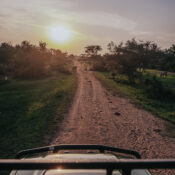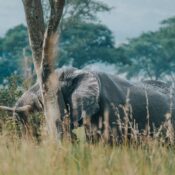African buffalo
African buffalo

COMMON NAME: African buffalo Scientific
NAME: Synceruscaffer
TYPE: Mammals
DIET: Herbivore
GROUP NAME: Herd Average
LIFE SPAN IN THE WILD: 11 to 22 years
AVERAGE LIFE SPAN IN CAPTIVITY: Up to 29 years
SIZE: 4 to 5 feet tall
WEIGHT: 660 to 1,840 pounds
A pest to ranchers, a prize to hunters, and a temperamental tank to anything that bothers it, African buffalo roam by the thousands in sub-Saharan Africa.
African buffalo, one of four distinct subspecies of the African buffalo, are the most common. They’re distinguished by coloring, size, and even horn shape. There’s also the forest buffalo, the West Africa savanna buffalo, and the Central Africa savanna buffalo.
When the buffalo aren’t fighting off the occasional lion, they’re eating grass—and lots of it. It forms the bulk of their diet. Like cows, buffalo chew cud to further extract nutrients.
African and bison aren’t the same animals. How the misnomer came to be is murky, but it’s thought early American settlers called bison “buffalo” because they look similar large, brown, hulking beasts that graze but the two animals are actually from different geniuses within the bovine subfamily. A quick ID tool is looking for a beard: Bison have them and buffalo don’t.
Herd mentality in African buffalo
African buffalo are hardy critters, able to live and flourish in many habitats from semi-arid bush land to coastal savannas to lowland rain forests as long as they’re close to a water source.
The ungulates are found starting in southwest Ethiopia and through Kenya, Uganda, Rwanda, Tanzania, Zambia, and Malawi, with patchier distribution through Angola, Mozambique, and Swaziland.
They’re also present in South Africa, and along the southwest coast in countries like the west African countries of Guinea, Sierra Leon, Liberia, Ivory Coast, Ghana, Benin and the southern part of Burkina Faso.
Buffalo are often pictured covered in mud with a bird on their back. The mud helps buffalo get rid of ticks and parasites that latch onto their skin. Birds such as ox peckers, for example, ride on the back of the buffalo and eat lice, fleas, and other parasites while getting a lift.
Buffalo spend most of the year in herds of anywhere between 50 and 500, but that number jumps up into the thousands in the Serengeti during the rainy season.
Gathering in such large groups helps dissuade predators like lions, leopards, hyenas, and African wild dogs. Older male buffalo, though, often strike out in smaller clusters or on their own.
Meanwhile, calves spend up to a year and a half suckling and are completely dependent on their mothers during this time.

Horns and hooves of the African buffalo
Buffalo are considered one of the “big five, a term grouping them with leopards, rhinoceroses, elephants, and lions as the most dangerous animals to hunt in Africa.
Hunting websites refer to the buffalo as “black death” for its dangerous personality—they’re known to be grumpy and unpredictable. And they can run up to 37 miles per hour. Because of this, they’re considered prize trophies by big game hunters.
In 2018, a South African big game hunter was gored to death when a buffalo blindsided after he shot and killed another member of the herd. Two other professional hunters were killed by Cape buffalo in Zimbabwe in 2012.
The Cape buffalo’s curved horns add to the stature of an already imposing animal, which can reach seven feet from tip to tail. Horns can help distinguish age and sex. In large adult males, the horns meet in the middle of their heads and are joined by a hard shield called a “boss.” This creates a helmet-esque formation. The horns are used for defense and to determine dominance for mating. Females also have horns that are narrower and smaller.
Savannah buffalo have horns that curve down and then up and in, like a hook, while forest buffalo have much shorter horns that are straighter and angle
Humans, crops, and cattle
African buffalo are considered “near threatened” by the International Union for the Conservation of Nature, which determines the conservation listings for species, because its numbers have been decreasing. There are about 400,000 adult buffalo in Africa, according to the IUCN.
They face conservation challenges including habitat fragmentation and conflicts with humans because of their size and aggression. In East Africa, buffalo are known to break fences and tear through crops.
They can also spread diseases to livestock, including foot-and-mouth disease and bovine tuberculosis. The opposite is also true. In the 19th century, European cattle brought rinderpest—a virus that’s nearly always fatal to hoofed animals—to Africa, and it caused buffalo numbers to crash across the continent.
Buffalo are also sometimes poached for bush meat.

for more information visit
All Categories
Recent Posts
Kidepo Valley National Park
The Kabaka’s lake
What is the African elephant?
Tags
Quick booking process
+256 393254072


